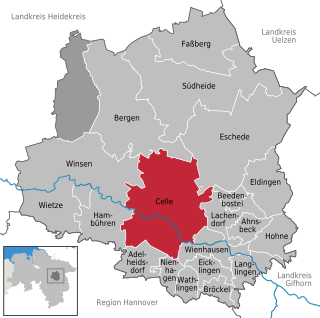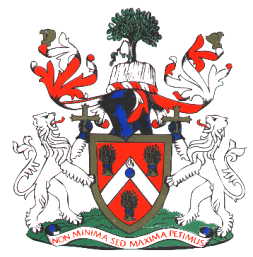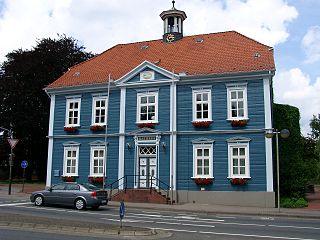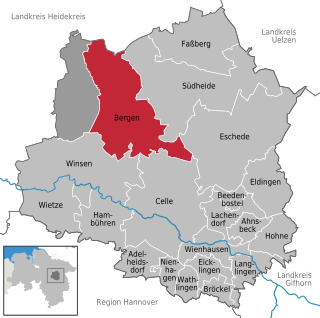
Wernigerode is a town in the district of Harz, Saxony-Anhalt, Germany. Until 2007, it was the capital of the district of Wernigerode. Its population was 35,041 in 2012.

Celle is a town and capital of the district of Celle, in Lower Saxony, Germany. The town is situated on the banks of the river Aller, a tributary of the Weser and has a population of about 71,000. Celle is the southern gateway to the Lüneburg Heath, has a castle built in the Renaissance and Baroque style and a picturesque old town centre with over 400 timber-framed houses, making Celle one of the most remarkable members of the German Timber-Frame Road. From 1378 to 1705, Celle was the official residence of the Lüneburg branch of the dukes of Brunswick-Lüneburg who had been banished from their original ducal seat by its townsfolk.

Newton Aycliffe is a town in County Durham, England. Founded in 1947 under the New Towns Act of 1946, the town sits about five miles to the north of Darlington and ten miles to the south of Durham. It is the oldest new town in the north of England, and together with the bordering Aycliffe Village and the north part of School Aycliffe, forms the civil parish of Great Aycliffe. The population of the town at the time of the 2011 census was 26,633.

Soltau is a mid-sized town in the Lüneburg Heath in the district of Heidekreis, in Lower Saxony, Germany. It has around 22,000 inhabitants. The city is centrally located in the Lüneburg Heath and is known nationwide especially for its tourist attractions like the Heide-Park and the Soltau-Therme.

Fairford Leys is a housing development in Aylesbury, Buckinghamshire, England, designed in the urban village style, with the street and block layout geared to pedestrians more than cars. The three main developers of the development were bound by a design code to ensure architectural cohesion and this is maintained through covenants on the deeds of each property.

Heusenstamm is a town of over 18,000 people in the Offenbach district in the Regierungsbezirk of Darmstadt in Hesse, Germany.

Öhringen is the largest town in Hohenlohe (district) in the state of Baden-Württemberg, in southwest Germany, near Heilbronn. Öhringen is on the railline to Schwäbisch Hall and Crailsheim.

Bergen is a town in the north of Celle district on the Lüneburg Heath, in Lower Saxony, Germany. Administratively it acts as a municipal borough divided into 12 subordinate parishes based on the town and its surrounding villages: Becklingen, Belsen, Bergen, Bleckmar, Diesten, Dohnsen, Eversen, Hagen, Hassel, Offen, Sülze and Wardböhmen. Bergen-Belsen concentration camp was located in the area of Belsen.
Wymans Brook is a district in the north-west of Cheltenham, Gloucestershire, England, named after the small river which flows through the district. It is situated relatively close to Cheltenham racecourse, Pittville Park, the Prince of Wales Stadium/ Leisure @ Cheltenham and the area of Cheltenham known as "Swindon Village".

Redditch is a town and local government district in north-east Worcestershire, England. The town is divided into separate districts. All street-name signs in Redditch have the street name in white lettering on a blue background and the district name in black lettering on a white background at the bottom of the sign. In the New Town areas the roads are usually named in alphabetical order and house numbering in the cul-de-sac closes is consecutive, starting with number 1 as the first house on the left as you enter, and the highest house number will be on the opposite side of the road as you leave.

The Lachte is a 38-kilometre-long (24 mi) right-hand tributary of the Aller in the Südheide Nature Park in the north German state of Lower Saxony.

Sülze is a village in the local borough of Bergen located in the northern part of Celle district on the Lüneburg Heath in North Germany. The infamous Bergen-Belsen concentration camp was located not far from Sülze, one of several farming villages in the borough. The general Bergen area today is economically heavily dependent on the surrounding military bases and the Bergen-Hohne Training Area to the west, which is the largest military training area in Western Europe.

Eversen is a village in the town of Bergen in the northern part of Celle district on the Lüneburg Heath in the north German state of Lower Saxony.

Altencelle is part of the borough of Celle in Lower Saxony and lies southeast of the town centre, west of the River Aller and east of the Fuhse. It is linked to Celle by the B 214 federal road and state highway K 74.

Garßen is a Lower Saxon village in the southern part of the Lüneburg Heath and, since 1973, part of the borough of Celle in Germany. It lies on the northeastern side of the town.

The village of Klein Hehlen was incorporated in 1939 by law into the adjacent town of Celle. The suburb is northwest of the town centre.

Westercelle is a suburb of the district town of Celle in Lower Saxony, Germany, that lies 3 kilometres south of the town centre on the river Fuhse.

Neuenhäusen is a suburb of the town of Celle in Lower Saxony, Germany, and lies south of the Altstadt in its centre. A particular feature of this suburb is that it is where most of the many authorities and public institutions, that have their headquarters in Celle, are located.

Wietzenbruch is a suburb in the southwest of the Lower Saxon town of Celle, which was named after the fen wood (Bruchwald) bisected by the river Wietze. Originally, the centre of Wietzenbruch was a small estate farm.

The Bundesstraße 214 is a federal road that runs from Lingen to Brunswick in North Germany.















